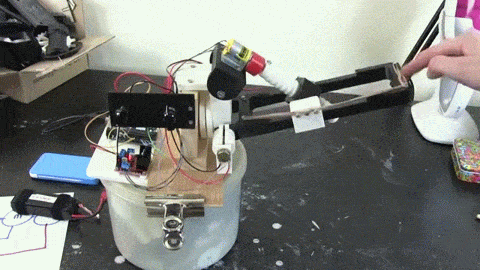Perhaps one of the most interesting YouTube channels to follow right now is [James Bruton’s] channel for XRobots.co.uk — he’s a prop maker, a toy maker — and as his site implies, a robotics guru. Put them altogether and watch him make some of your childhood dream projects come true. He’s currently working on a real-life robot creation of Ultron, and he’s messing around with Series Elastic Actuators right now.
In an earlier part of the project, he built a small robotic arm to demonstrate the motion capture suit he’s going to use to control Ultron (if all goes according to plan he’ll have a walking robot following his every move!). He showed how the basic RC servo motor driven arm works, and how it probably wouldn’t be the best to scale up since it has no external feedback — if he has a full size Ultron robot swinging its arms around, someone could get hurt.
Which led him to designing his own prototype Series Elastic Actuators using an Arduino, potentiometers, some elastics, and a geared DC motor.
As he breaks it down in the video, it’s actually fairly easy to understand. The 3D printed leadscrew mechanism he built is mounted to a linkage restrained by an elastic. This gives the system a bit of flex before any of the parts can get damaged.
A potentiometer on the joint measures the angle of the arm, and a second linear actuator measures the position of the motor mount along the arm. Under no load, the two potentiometer values can be compared by the Arduino for positioning. Introduce external feedback, and the Arduino will notice a mismatch between the two potentiometer values, allowing the robot to stop pushing (or keep pushing depending on how he programs it).
It’s pretty awesome stuff as it is — but to [James] it’s all just basic R&D until he builds the real thing.
As always we love [Bruton’s] videos because of the great detail he goes into — and thanks to his formidable collection of 3D printers, he makes almost all the parts himself. Have you seen his fantastic BB-8 droid build? He also has a full Iron Man costume, and a Hulkbuster version to boot — not to mention a pretty awesome Wii-mote controlled Dalek.
[Thanks Llyod!]
















i wonder what hes got planned for the brain… my best suggestion is to combine markov chains with genetic algorythms.
I did a similar thing with hobby servos and ratiometric linear hall effect sensors:
http://youtu.be/tEfguBSO4hA
The video shows the force summed from four servos, such that you can “feel” the forces “felt” by the other servos. So the arm not only stops when it hits something, you also know it hit something. ;)
That’s really neat! How did you get force from the servos? I looked up these ratiometric hall sensors, but they are about measuring magnetic field strength. Are you measuring the current draw by the motor? Would it work with hydaulics too?
It does use a small magnet for the force feedback.
http://youtu.be/LoqGDTH75jY
The video shows how it works, and a few different sensing methods.
Very cool! I feel like I need to build me one of these…
May I ask what sensor you used? Something by Allegro? http://www.digikey.com/product-detail/en/A1304ELHLX-T/620-1548-1-ND/4552949 ?
Yup, that is the same one I used.
Enjoy. :)
This is the sort of thing I come to hackaday for: Can you submit something as a full story? Your wolf head is amazing too. Can you increase the sensitivity more by increasing the gain on the linear hall effect sensor, I’m thinking of the no-cut design and whether you could get the same lightness of touch that way.
Writing it up now ;-)
I’m quivering in anticipation!
So what’s the math to measure the torque? Hooks law and some trig?
Also, check out series parallel elastic actuators:
https://www.youtube.com/watch?v=9MvlQ854rLY
Isn’t that something similar?
https://www.youtube.com/watch?v=sjFR4ACVLmk
I don’t think he needs the linear pot because he’s already measuring the arm angle with another pot…
That should be even better than the the linear pot solution IMO.